Analysis
This topic provides a detailed examination of applications, users, queries, entities, files, and more. Based on the pre-defined SLAs, cost, resource consumption, etc., the Analysis page shows a glimpse into the most eligible workloads for migration.
In an integrated assessment, the analysis section is segregated into various sub-sections such as DML Script, ETL Script, Jobs Script, and BI Script based on workloads.
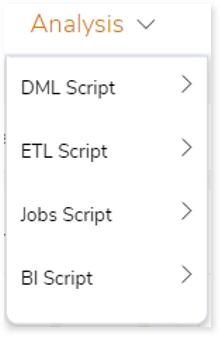
In this Topic:
DML Script
Applications
This section provides a summary for all the applications comprising of execution time required for the application, CPU, and I/O utilization of applications and so on.

- Application Name: Name of the application.
- Execution Time (%): Percentage of time required to execute the application.
- CPU (%): Percentage of CPU utilization.
- I/O (%): Percentage of I/O utilization.
- Total Schemas: Provides the total number of schemas.
- Total Queries: Provides the total number of queries.
- Number of Users: Provides the total number of users in the application.
Browse through each application to get more information about the queries, schemas, and users.
Queries
Displays a list of queries along with its analysis status, complexity and so on.
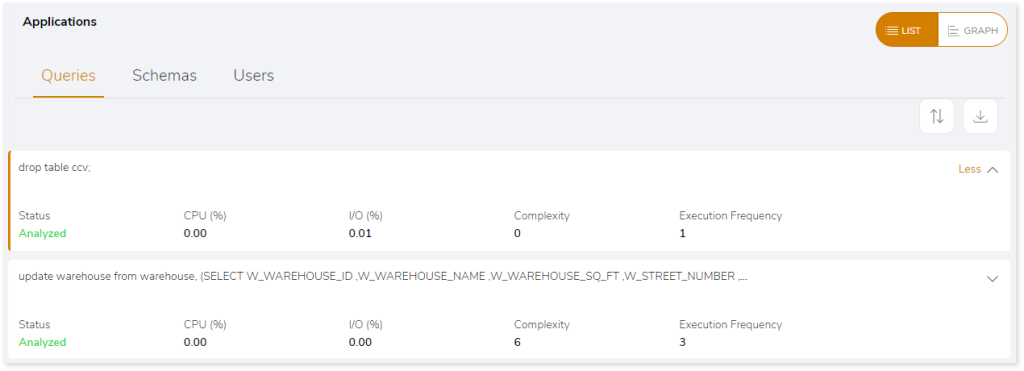
- Status: Displays the query analysis status as Analyzed or Not Analyzed.
- Analyzed: Indicates the query is analyzed.
- Not Analyzed: Indicates the query is not analyzed due to some impediments. If the query status is not analyzed, then it displays the reason for failure.
- CPU (%): Percentage of CPU utilization.
- I/O (%): Percentage of I/O utilization.
- Complexity: Provides the complexity of queries.
- Execution Frequency: Provides the frequency of execution.
Schemas
Displays a list of schemas along with the execution time, number of tables, and so on.

- Schema Name: Name of the schema.
- Execution Time (%): Percentage of time required to execute the application.
- CPU (%): Percentage of CPU utilization.
- I/O (%): Percentage of I/O utilization.
- No. of Tables: Displays the number of tables in the schema.
- Unique Queries (Text): Displays the number of unique queries.
Users
Displays a list of users along with the execution time, total number of queries, unique queries and so on.

- User Name: Name of the user.
- Execution Time (%): Percentage of time required to execute the application.
- CPU (%): Percentage of CPU utilization.
- I/O (%): Percentage of I/O utilization.
- Unique Queries (Pattern): Displays the number of unique pattern queries. Unique pattern queries identify the distinct query structures, but the query structure’s values may change.
- Unique Queries (Text): Displays the number of unique queries. In Unique Queries (Text), the duplicate queries are eliminated, and solitary queries are identified.
- Total Queries: Displays the total number of queries.
The GRAPH section illustrates a detailed analysis of all applications. It displays the graphical view of execution time required for the application, CPU, and I/O utilization of applications and so on.
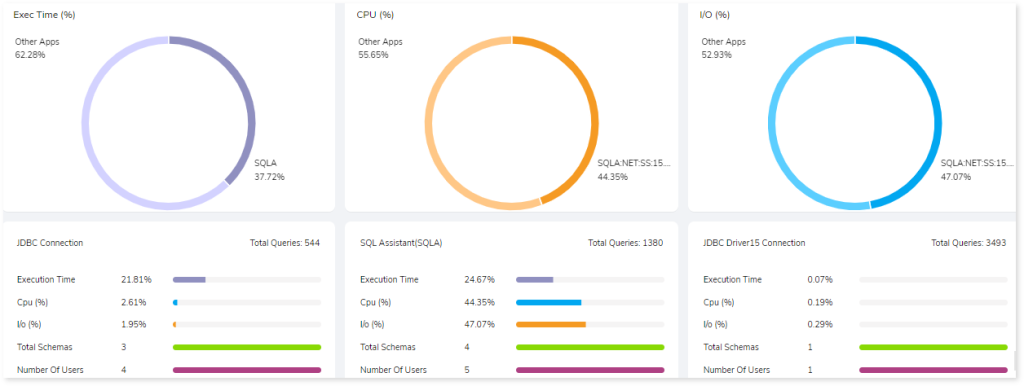
Users
This section provides a summary for all the users comprising of execution time required for the users, CPU, and I/O utilization of users and so on.

- All Users: Displays a list of all users.
- Execution Time (%): Provides the execution time for users in percentage.
- CPU (%): Percentage of CPU utilization.
- I/O (%): Percentage of I/O utilization.
- Total Queries: Provides the total number of queries.
Browse through each user to get more insights regarding the associated schemas and applications.
Schemas
This section provides details about the schemas associated with the users.

- Schema Name: Name of the schema.
- Execution Time: Time required for the execution.
- CPU (%): Percentage of CPU utilization.
- I/O (%): Percentage of I/O utilization.
- No. of Tables: Provides the number of tables.
- Total Queries: Provides the total number of queries.
Applications
This section provides details about the applications associated with the users.

- Application Name: Name of the application.
- Number of Total Queries: Displays the total number of queries.
- Unique Queries (Pattern): Displays the number of unique pattern queries. Unique pattern queries identify the distinct query structures, but the query structure’s values may change.
- Unique Queries (Text): Displays the number of unique queries. In Unique Queries (Text), the duplicate queries are eliminated, and solitary queries are identified.
- Execution (%): Provides the execution time for application in percentage.
- CPU (%): Percentage of CPU utilization.
- I/O (%): Percentage of I/O utilization.
The GRAPH section illustrates a detailed analysis of all applications. It displays the graphical view of execution time required for the users, CPU, and I/O utilization of users and so on.
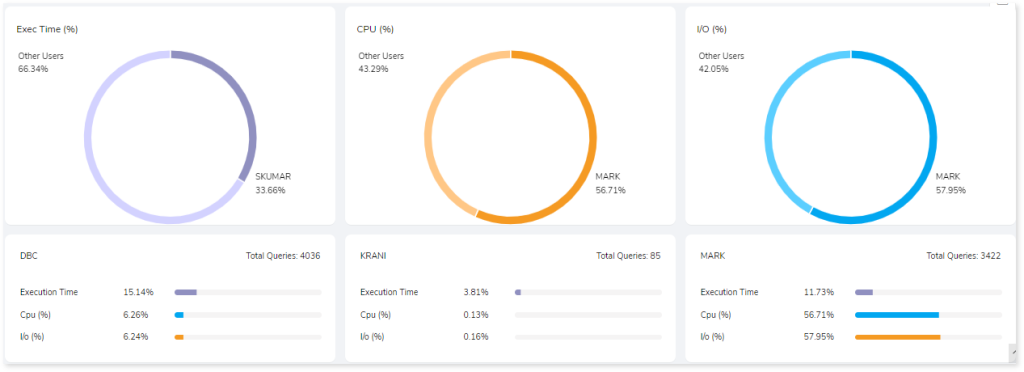
Files
This section provides a comprehensive report of the source files with information about the total number of files, jobs, complexity, and queries associated with each file.

Click the preferred File Name row to gain more insights into the queries present in each file. Here, the queries are categorized into used queries and unused queries.
- Unique (Text): Duplicate queries are eliminated, and solitary queries are identified.
- Used Queries: Displays the number of queries that are used in both DML scripts and Execution logs.
- Unused Queries: Displays the number of queries that are used in DML scripts but not in Execution logs.
- Schema Name: Name of the schema.
- Complexity: Provides the complexity of queries.
- Execution Frequency: Provides the frequency of execution.
The GRAPH section displays the graphical view of files comprising execution time (%), I/O (%), and CPU (%).

Orchestration Inventory
This section provides a complete analysis of the jobs. Jobs are the orchestration scripts (such as AutoSys or Control-M) that run in a certain order to perform a set of activities.

Queries
This page displays graphical (GRAPH) and detailed (LIST) analysis of unique and analyzed queries from the total input queries after considering the different SLAs. Moreover, it presents details about the unique query text, unique query patterns, and analyzed and not analyzed queries.
Unique (Text)
This section displays a list of all the unique queries. Additionally, it shows the total number of unique queries and the number of queries segregated by the statement type. In Unique (Text), the duplicate queries are eliminated, and solitary queries are identified.

- Status: Displays the query analysis status as Analyzed or Not Analyzed.
- Analyzed: Indicates the query is analyzed.
- Not Analyzed: Indicates the query is not analyzed due to some impediments. If the query status is not analyzed, then it displays the reason for failure.
- Complexity: Displays the query complexity.
Unique (Pattern)
This section displays a list of all queries with unique patterns. Additionally, it shows the total number of unique pattern queries and the number of queries segregated by the statement type. Unique pattern queries identify the distinct query structures, but the query structure’s values may change.

Analyzed
This section displays a list of all queries that meet the analysis criteria. Additionally, it shows the total number of analyzed queries and the number of queries segregated by statement type.

- Status: Displays the query analysis status as Analyzed or Not Analyzed.
- Analyzed: Indicates the query is analyzed.
- Not Analyzed: Indicates the query is not analyzed due to some impediments. If the query status is not analyzed, then it displays the reason for failure.
- Complexity: Displays the query complexity.
Not Analyzed
This section displays a list of all queries that did not meet the analysis criteria. Additionally, it shows the total number of not analyzed queries as well as the number of queries segregated by statement type.

- Status: Displays the query analysis status as Analyzed or Not Analyzed.
- Analyzed: Indicates the query is analyzed.
- Not Analyzed: Indicates the query is not analyzed due to some impediments. If the query status is not analyzed, then it displays the reason for failure.
- Complexity: Displays the query complexity.
The GRAPH section illustrates a detailed analysis of all queries. It demonstrates query distributions based on unique text, unique pattern, analyzed and non-analyzed queries, etc.
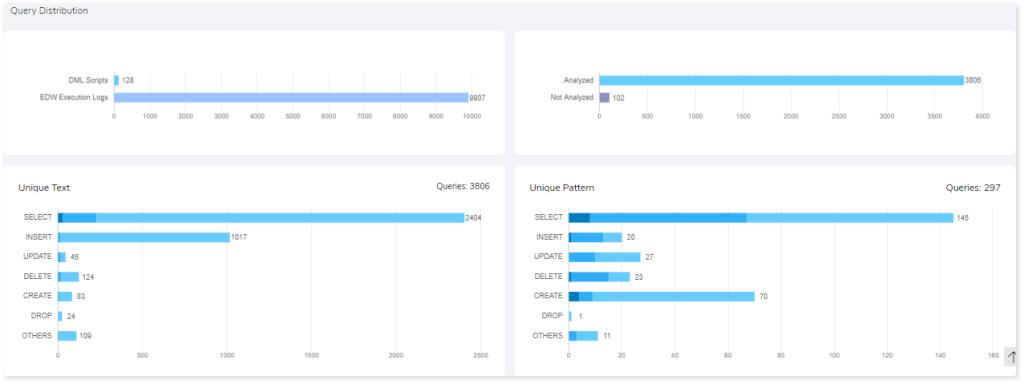
Entities
This section displays graphical (Graph View) and detailed analysis (List View) for the analyzed entities based on the frequency of use and provides information about all the available tables and views used in the queries. Entities are:
- Tables: Encapsulates information about All Tables, Used Tables, Unused Tables, and Missing Tables.
- Views: Contributes information about All Views, Used Views, Unused Views, and Missing Views.
| Entities | Description |
| Tables | All Tables | Total tables available in the source file. |
| Used Tables | Tables which are used in both DML scripts as well as Execution logs. |
| Unused Tables | Tables which are used in DML scripts but not in Execution logs. |
| Missing Tables | Tables which are present in DML scripts but not in DDL scripts. |
| Views | All Views | Total views available in the source file. |
| Used Views | Views which are used in both DML scripts as well as Execution logs. |
| Unused Views | Views which are used in DML scripts but not in Execution logs. |
| Missing Views | Views which are present in DML scripts but not in DDL scripts. |
Tables
Encapsulates information about All Tables, Used Tables, Unused Tables, and Missing Tables.
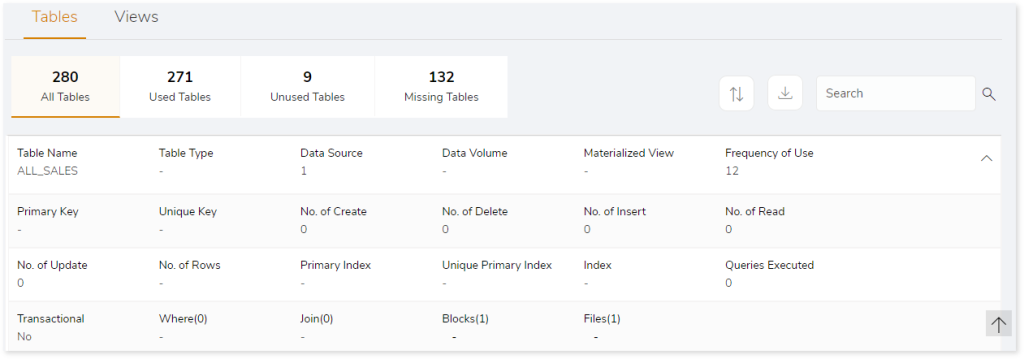
- Table Name: Name of the table.
- Table Type: Type of the table.
- Data Source: Displays details of the data source.
- Data Volume: Displays the quantity of data.
- Materialized View: These are queries used to store data in the physical tables where you can define to update the table automatically when changes are made in the source tables or execute a command to update the tables.
- Frequency of Use: Displays the frequency of table used.
- Primary Key: To identify unique row in the table. It will not accept NULL values.
- Unique Key: To identify records in a table.
- No. of Create: Displays number of CREATE queries in the table.
- No. of Delete: Displays number of DELETE queries in the table.
- No. of Insert: Displays number of INSERT queries in the table.
- No. of Read: Displays number of READ queries in the table.
- No. of Update: Displays number of UPDATE queries in the table.
- No. of Rows: Displays number of rows in the table.
- Primary Index: Indexes based on the primary key.
- Unique Primary Index: Contains unique values in the column of the index table.
- Index: Indexes are lookup tables that help to quickly retrieve data from the database.
- Queries Executed: Number of queries that are executed.
- Transactional: Displays the number of data flow components that are used to perform sorting, merging, data cleansing and so on.
- Where: Displays number of Where clause.
- Join: Displays number of Joins.
- Blocks: Displays number of blocks.
- Files: Displays the name of the associated file.
Views
Lists all the views along with information about the number of used tables and views, databases, details of child tables and views.

- View Name: Displays the name of the views.
- Number of Used Tables: Displays the number of used tables.
- Number of Used Views: Displays the number of used views.
- Database Name: Provides the name of the databases.
- Child View: Provides details of the child views.
- Child Table: Provides details of the child tables.
The Graph View of entities displays a graphical illustration of detailed entity analysis after considering different SLAs. In this visual summary, you can see the distribution of tables, views, and entities, as well as information about Permanent, Temporary, or Intermediate table types.
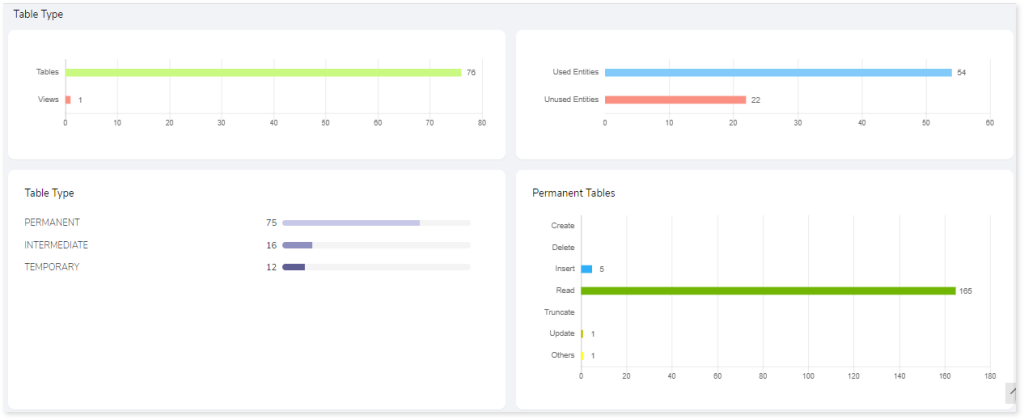
Artifacts
This section gives details about artifacts (collections of related server data). Artifact types are:
- Missing Artifacts: When artifacts are absent or not recognized in a configured assessment, or a dependency cannot be recognized, they are considered missing artifacts. For example, a KSH script is referred to in an Informatica job, but it is not supplied in the input, which should be reported as missing artifacts.
- Additional Artifacts: Artifacts that do not have a reference in the input artifacts are referred to as additional artifacts.
- Unparsed Artifacts: Unparsed artifacts are artifacts that are unable to be parsed by the engine.
Missing Artifacts
This section provides the details of all the missing artifacts. Additionally, this section categorizes the missing artifacts into files and entities that are missing.
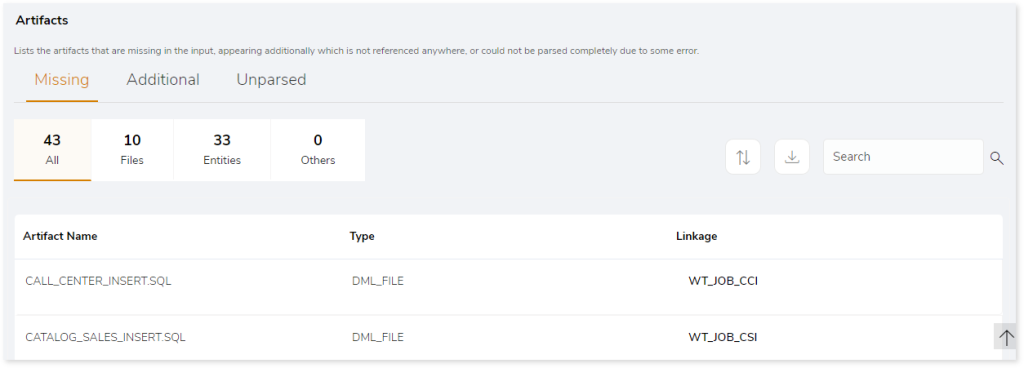
- Artifact Name: Name of the artifact.
- Type: Provides the artifact type such as a file, table, view etc.
- Linkage: Provides the linked or associated file names.
Additional Artifacts
This section provides the details of all the artifacts that appear additionally. It also categorizes the additional artifacts into files and entities that appeared additionally.
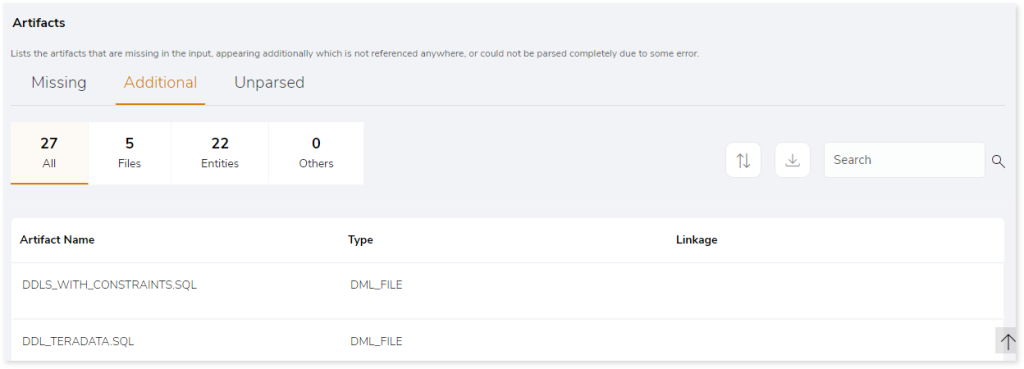
- Artifact Name: Name of the artifact.
- Type: Provides the artifact type such as a file, table, view etc.
- Linkage: Provides the linked or associated file names.
Unparsed Artifacts
This section provides the details of all the artifacts that could not be parsed completely due to some error.

- File Name: Name of the file on which the unparsed query is present.
- Type: Type of the file.
- Error on Line Number: Displays the line number that contains the error.
ETL Script
Source Analysis
This section provides a comprehensive report of the source files with information about the total number of files, source databases, workflows, complexity, external files, and so on.

- File Name: Name of the file.
- Source Databases: Provides details about the source database.
- Workflows: Set of instructions to perform various actions.
- Mappings: Describes the flow of data between source and target.
- Transformations: Set of instructions to create, modify, or transform data to the target.
- Queries: Provides the total number of queries in the file.
- Complexity: Displays the complexity of the files.
- External Files: Files other than Informatica files.
Entities
This section displays a detailed analysis of the entities comprising the available and missing tables.
Tables
This section provides details about the tables used in the Lookup transformation, source, and target. The Lookup transformation is used to calculate field values from the source, source qualifier, or target to retrieve required data.

- Table Name: Name of the table.
- Data Source: Provides details of data source.
- Source Database: Provides the details of the source database.
- Frequency of Use: Provides the frequency of table usage.
Missing Tables
This section provides a list of all the missing tables.

- Table Name: Name of the table.
- Frequency of Use: Provides the frequency of table usage.
Scheduler
This section provides information about the jobs including the types, status, start time, and more.

- Scheduler Name: Displays the name of the scheduler.
- Scheduler Type: Displays the type of the scheduler such as ONDEMAND, Continuous, etc.
- Start Date & Time: Displays the job execution start date and time.
- End Date & Time: Displays the job execution end date and time.
- Frequency: Displays the frequency of the scheduled jobs such as daily, weekly, monthly, etc.
- Interval: Displays the frequency interval of the scheduled jobs.
- Filters: To filter the data based on specific requirements. For example: Run the job only for specific geography.
- Associated Workflow: Displays information about the associated workflow.
Workflows
This section provides a summary of workflows with information about mappings, complexity, and associated files.

- Workflows Name: Name of the workflow.
- File Name: Displays the associated source file.
- Mapping: Describes the flow of data between source and target.
- Complexity: Displays the complexity of the workflows.
Artifacts
This page gives details about artifacts-collections of the related server data. It provides a list of missing artifacts, artifacts that appear additionally, or could not be parsed completely due to some error.
Missing Artifacts
This section provides the details of all the missing artifacts. Additionally, it categorizes the missing artifacts into files and entities that are missing.This section provides the details of all the missing artifacts. Additionally, it categorizes the missing artifacts into files and entities that are missing.

- Artifact Name: Displays name of the artifact.
- Type: Provides the type of the artifacts such as file, table, etc.
- Linkage: Provides the linked or associated file names.
Additional Artifacts
This section provides the details of all the artifacts that appear additionally. It also categorizes the additional artifacts into files and entities.

- Artifact Name: Displays name of the artifact.
- Type: Provides the type of the artifacts such as file, table, etc.
- Linkage: Provides the linked or associated file names.
Unparsed Artifacts
This section provides the details of all the artifacts that could not be parsed completely due to some error.

- File Name: Displays the name of the unparsed artifact.
- Message: Displays the reason why the artifact is marked as unparsed.
Invalid
This section lists all the invalid artifacts.

- Message: Displays the reason why the artifact is marked as invalid.
- File Name: Displays the name of the invalid artifact.
Job Script
Jobs
This section provides a complete analysis of the jobs. Jobs are scheduler scripts (such as AutoSys or Control-M) that run in a certain order to perform a set of activities. It lists all the jobs along with the information about jobs such as types, status, start time, and more.
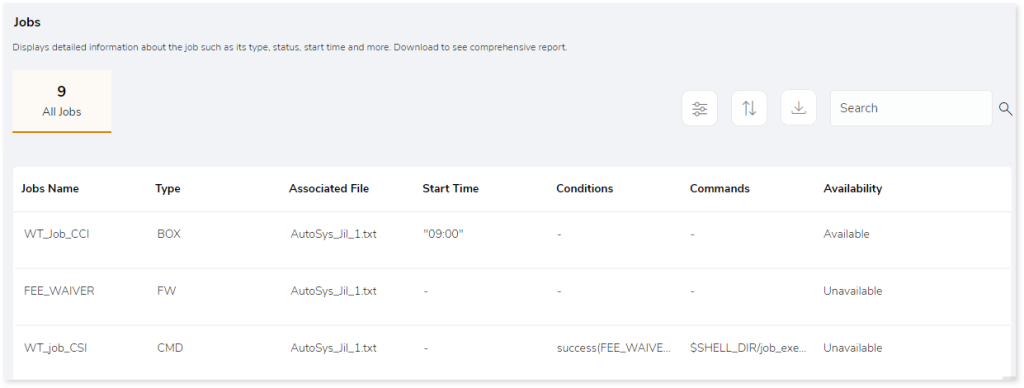
- Jobs Name: Displays the name of the jobs.
- Type: Displays the type of jobs such as box, FW, CMD.
- Associated File: Displays the name of the source scripts that are associated with the jobs.
- Start Time: Displays the job execution time.
- Conditions: Displays the conditions that must be met for a job to run.
- Commands: Displays the commands used in the jobs.
- Availability: Displays the availability of jobs.
- Available: Jobs that are available in both scripts and execution logs.
- Unavailable: Jobs that are available in scripts but not in execution logs.
Artifacts
This section lists all the artifacts that could not be parsed completely due to some error.
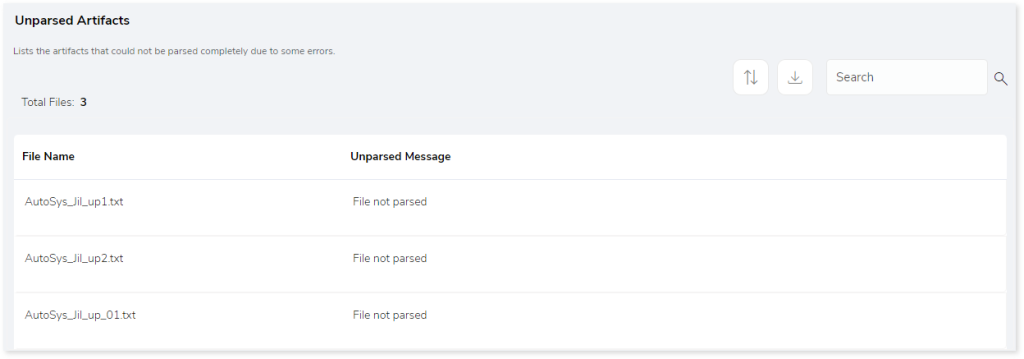
- File Name: Displays name of the artifact.
- Unparsed Message: Displays the reason for not parsing the file.
BI Script
Files
This section provides a comprehensive report of the source file including file name, queries, pages, and so on.

- File Name: Lists all the files.
- Queries: Provides the total number of queries in the file.
- Pages: Displays the number of pages in the file. It contains information like visualizations or maps.
- Reports: Displays the number of reports in the file. It contains all the data including pages, calculated columns, etc.
Packages
This section displays detailed information about packages, including reports, namespaces, and more.

- Package Name: Displays the name of the packages.
- Reports: Displays the number of reports in the package.
- Namespaces: Displays the number of namespaces in the package.
- Associated File: Displays the name of the associated file.
Reports
This section provides a summary of the reports including visualization objects, calculated columns, queries, pages, and so on.

- Report Name: Name of the report.
- Visualization Objects: Provides the details of maps or visualization objects.
- Columns: Provides details of the columns, such as the column name, usage type, and calculated column.
- Calculated Columns: Columns in which aggregate functions such as min, max, sum, avg, etc. are implemented for calculation.
- Queries: Provides the number of queries.
- Pages: Provides details of the pages such as number and name of the pages.
- Filters: Displays the number of filters in each report.
- Table: Displays the number of tables in each report.
- Namespaces: Displays the number of namespaces associated with each report.
- Complexity: Displays the complexity of files.
- Associated files: Displays the files associated with the reports.
Pages
This section provides a summary of the pages including visualization objects, and associated reports for every page.

- Page Name: Name of the page.
- Visualization Objects: Provides details of maps or visualization objects.
- Associated Report: Displays the reports associated with the pages.
Queries
This section provides a comprehensive summary of all queries found in reports and packages including both parsed and unparsed queries.
Report
This section provides a view of all queries, including parsed and unparsed queries present in the reports.

- Query Name: Name of the queries in the source files.
- Report Name: Displays the associated report names.
- Columns: Provides the details of columns such as name of the columns, usage type and confirm whether it is the Calculated columns.
- Filters: Provides the details of filters in each query.
- Complexity: Displays the complexity of queries.
Packages
This section provides a view of all queries, including parsed and unparsed queries present in the packages.

- Table Name: Name of the table in the source files.
- Namespaces: Provides information about the namespaces in the package.
- Columns: Provides the details of columns such as name of the columns, usage type and confirm whether it is the Calculated columns.
- Filters: Provides the details of filters in each table.
- Complexity: Displays the complexity.
Entities
This section displays a detailed analysis of the entities. It includes information about entity types, databases, database types, and more.

- Table Name: Displays the name of the table.
- Namespace: Displays the name of the namespace associated with the table. It is a set of entities used to manage and organize data.
- Folder: Displays the folder name associated with the table.
- Data Source: Specifies the database details from which the table originate.
- Connection Type: Provides the connection details. The connection types are:
- Direct: Refers to original physical table available within the database. For instance, RETAILER_SITE represents original physical table.
- Indirect: Refers to derived tables or empty database.
Namespaces
This section displays detailed information about namespaces, including tables, relationships, filters, and more.

- Namespace Name: Displays the name of the namespaces.
- Folder: Displays the number of folders present in namespaces. Folders are subset of namespaces.
- Relationships: Displays the number of relationships established between tables within the namespace. These relationships typically define how one table is linked to another table.
- Tables: Displays the number of tables in each namespace.
- Filters: Displays the number of filters in each namespace.
- Calculations: Displays the number of calculations in each namespace.